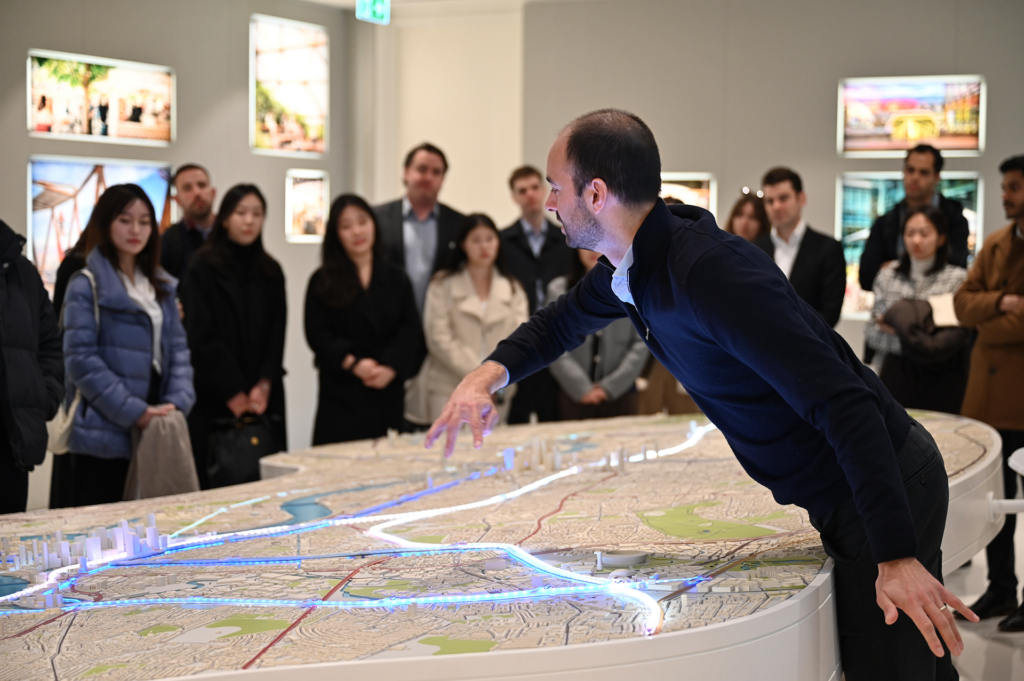This semester, the Paul Rubacha Department of Real Estate, jointly led by the College of Architecture, Art, and Planning (AAP) and the Cornell SC Johnson College of Business, welcomes Professor Stuart S. Rosenthal as the department’s inaugural chair. Previously the Maxwell Advisory Board Professor of Economics and a senior research associate at Syracuse University’s Center for Policy Research, Rosenthal brings to his new position a deep understanding of the interconnected forces that push communities to grow and change. In collaboration with fellow faculty, he is poised to lead a department that educates tomorrow’s leaders in the multidisciplinary field of real estate, spanning the built environment, finance, and social policy.
Molly Sheridan
Your path to the study of real estate markets and cities has largely been through economic considerations. How has your interest in economics led to this deep intersection with real estate?
Stuart S. Rosenthal
All of my career I have been especially interested in learning more about the opportunities and challenges that arise in cities. Around the world, cities are mostly engines of growth, enhancing labor productivity and contributing to rising standards of living. There are reasons for this, grounded in economics: entrepreneurs choose to operate in expensive cities because proximity to other companies is valuable. But the marvel of urban productivity is not without cost. Cities also suffer from congestion, pollution, and, in many instances, social tensions associated with inequities. Some of those tensions arise as a consequence of urbanization, as is often the case with the sorting of high- and low-income families into different neighborhoods, and the subsequent differences in access to local services (e.g., resources for local schools). In other instances, urbanization has the potential to amplify racial and ethnic differences, especially when race and ethnicity are correlated with income. This can reinforce segregation along demographic and cultural lines in ways that can impede economic opportunity and upward mobility.
Economics helps me think about how and why these patterns arise along with opportunities to enact policy, both in government and business practice, that has the potential to enhance the positive sides of urbanization while mitigating the negatives.
Stuart S. Rosenthal
Economics helps me think about how and why these patterns arise along with opportunities to enact policy, both in government and business practice, that has the potential to enhance the positive sides of urbanization while mitigating the negatives. In nearly all instances, decisions by households, entrepreneurs, and local government officials have direct effects or links with real estate markets, including property markets and financing. For example, the appeal of a neighborhood’s local amenities affects property values, as does the opportunity to build more housing. The presence of complementary businesses enhances the potential for new businesses to thrive, increasing commercial rent. The road and transit systems created by local governments affect the ability of individuals to travel between home and work, and that too affects property values and economic opportunities for residents in different communities. All such development requires financing, and so financial markets are intertwined with property markets. In short, very little happens in cities that is not directly related to real estate, broadly defined. A focus on cities requires a focus on the economics and financial aspects of real estate.

Molly Sheridan
What research questions have engaged you most or felt most pressing throughout your career?
Stuart S. Rosenthal
I see cities as having three major sets of decision-makers: households, entrepreneurs (business owners), and local government officials. Cities also have intrinsic advantages and disadvantages specific to their location. New York City’s natural harbor is an advantage, giving rise to its shipping industry that ultimately led to secondary developments like the Financial District and the Garment District. Upstate New York’s cold and snowy winters are a disadvantage, contributing to the outmigration of population to Sunbelt locations, brain drain, and reduced draw for companies that rely on local pools of skilled labor. I have worked on all of these issues and more, including the role of local and broader financial markets that support housing and business development. All affect the vitality of cities and real estate markets.
At different points in my career, I have written a number of papers on access to mortgage credit and how that affects housing opportunities for different types of households. In part, that work is related to access to homeownership and a legacy of racial discrimination in the mortgage and housing markets. It is also related to work on the potential for real estate prices to deviate from the underlying fundamentals of supply and demand. The 2007 financial crisis has its origins in the mispricing of real estate, the effects of which were amplified by problems in how mortgage credit was being provided. Together, that led to the Great Recession and so is an instance in which seemingly local patterns can contribute to far-reaching effects.
Other questions concern the rise and fall of residential neighborhoods and how that is related to underlying economic forces. That includes the presence but slow decay of durable housing, along with periodic waves of gentrification and redevelopment. These dynamics in the housing market affect where and when low- and high-income neighborhoods are found and the viability of different strategies to help ensure access to affordable, decent-quality housing for lower-income families.
Finally, and most recently, I have been working on how cities will change in the future. An obvious driver is the degree to which work-from-home (WFH) remains important in some industries. In a recent paper, my co-authors and I considered evidence of whether WFH is reducing the appeal of city centers, with implications for urban productivity, commercial real estate, and the spatial structure of how households and companies are organized. Evidence suggests that the answers differ across cities in part dependent on the type of industries present and transportation infrastructure.
I have worked on all of the above areas and more. But I’m not sure I can say one area is more important than another. They are all fundamental to the success and potential failure of individual cities, with direct implications for real estate markets. That said, I am likely best known for my work on productivity gains from the spatial concentration of companies and also my work on filtering — the idea that as homes age, they gradually filter down to lower-income families, affecting the location of low-income communities.

Molly Sheridan
You have sat on the editorial boards or served as an editor for numerous publications, and to say you have published widely yourself is an understatement. Why have you devoted so much of your career to contributing to the literature in these ways?
Stuart S. Rosenthal
There are really two questions here.
As for my research and related publishing, I have always been passionate about learning and trying to better understand people and the world around me. Pursuing an active research-oriented career, including at a university like Cornell, is a reflection of that. I also care about people, and for that reason, my work is often applied in nature with implications for business practice and public policy and the people affected by the success or failure of those institutions.
My contributions to editorial boards and my long term as editor of the Journal of Urban Economics (2007–2023) are a natural extension of the above. Academic research requires peer review and platforms if it is to resonate and have impact. The peer review process also requires a willingness among scholars to contribute to the effort, not just as authors but also as reviewers. I feel it is part of my professional role to do so.
Helping to lead the JUE as managing editor is a different role that goes beyond simply reviewing. I have had an opportunity to influence the journal’s character, focus, and style. My goal, along with others helping in the effort, has been to establish the JUE as the preeminent forum in which to exchange ideas related to the economics of cities and urbanization, most of which is directly related to real estate markets as suggested above. The journal has gained considerable depth and impact since 2007 as a team of absolutely terrific co-editors has helped to elevate the JUE. Having the opportunity to help lead that effort is special.

Molly Sheridan
The Paul Rubacha Department of Real Estate, launched just over a year ago, is the product of a novel partnership formed around the common interests of two colleges, AAP and the SC Johnson College of Business at Cornell. What unique opportunities does this multicollege department afford students and faculty? As the inaugural chair, what are your goals for its development?
Stuart S. Rosenthal
Given the scope of potential areas of emphasis within the broad hat called “real estate,” the potential path forward for the newly formed Paul Rubacha Department of Real Estate is very exciting. That is true for me, and I believe for the many stakeholders who provide valuable direction for current areas of focus and development, as well as for our students, who benefit from Cornell’s interdisciplinary approach to real estate education.
For example, few real estate departments and programs embrace a multidisciplinary structure, and none that I am aware of do so to the degree that is embedded in the Rubacha Department. Nevertheless, many development decisions by for-profit enterprises or local policy officials require input from a multitude of perspectives. The department Cornell has launched is designed to ensure a presence for different disciplinary perspectives that are all part of the real estate environment. This includes input from architecture, planning, law, finance, and economics.
The joint oversight of the department by AAP and the SC Johnson College of Business is indicative of the depth of conviction that real estate as a “field” benefits from input from multiple perspectives. This is absolutely true for students seeking to pursue careers in any number of facets of the real estate industry. It is also true for scholarly research.
At the same time, the different disciplinary perspectives that help to prepare students seeking careers in the real estate industry are generally siloed in their respective areas within academic institutions. That is natural: the tools of finance differ from the skills required in architecture, as do the tools used by economists and those in law and urban planning.
The great opportunity for students and faculty in the Rubacha Real Estate Department is to be exposed to the different disciplinary perspectives that contribute to a broader whole outside of academia. A challenge and a central goal for me in my role as chair of the department is to help create an environment where faculty and students with different types of training all contribute to common goals, including the value of the Baker M.P.S. program and the department’s research standing in its constituent disciplinary areas.
Molly Sheridan
The real estate industry is vast and career paths for those entering the field seem to be multiplying. Can you speak to what that means for today’s students?
Stuart S. Rosenthal
The key word in your question is “field.” That implies that there is a well-defined field of real estate. I would suggest there is not. Instead, I agree with the premise in the rest of your question, that there are many career paths through which individuals could find themselves participating in real estate markets in one manner or another. That could include investment banking, working as a developer of commercial or residential buildings, real estate finance at a local or global level, or in local government with responsibility for the design of zoning and other development restrictions.
Setting aside labels, it may be difficult for many students to know what facet of the real estate industry they want to focus on, at least at the start of the Baker M.P.S. program. The multidisciplinary nature of the program provides students with opportunities to explore different perspectives and to hopefully discover where their passion is, and to then focus more in that area. More generally, I believe it is valuable for students seeking careers in real estate to have depth in a subarea of the “field” while also having awareness of alternate perspectives that come up in so many settings.




